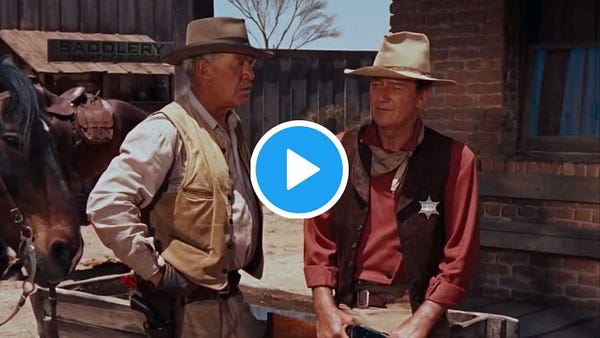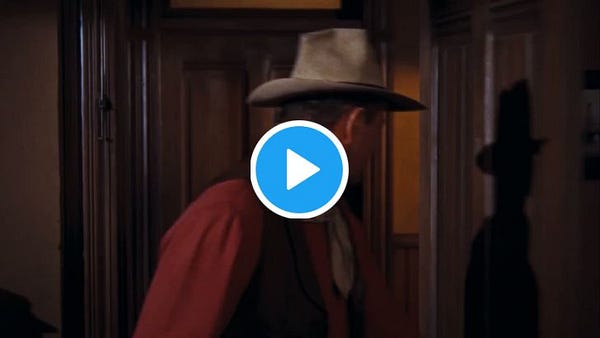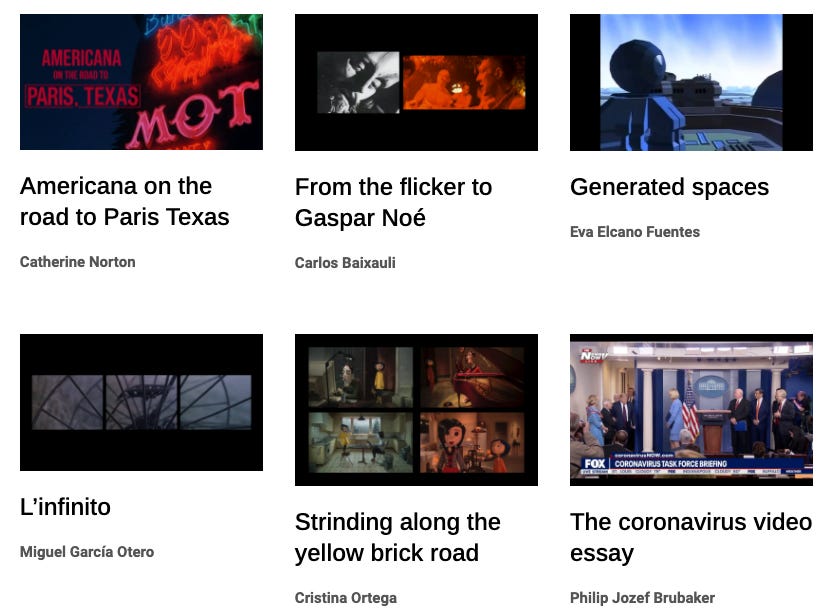Have you seen this video?
It made the rounds on Film Twitter back in March and since then I’ve watched it probably 50 times. There was a week or so when I would watch it every time I opened Twitter. Some of the replies are just as good in their own way:



And finally, a thought I also had:

In the videographic circles we swim in, there is a growing interest in short videos like this one produced for social media, especially for TikTok. It’s why I was so pleased to talk about “The Rise of Film TikTok” with Queline Meadows, and with Charlie Shackleton about “Criticism in the Age of TikTok” more than a year ago (wow!).
The clip above was created via WOMBO, an AI-powered lip sync app, before it was uploaded to social media. While (I assume) the video was originally made as a joke, I think there’s a lot to unpack here, and I would argue that the video is a form of videographic criticism. Much could be said about the use of AI, the ethical implications of this technology, the manipulation of sound, etc., but it’s the literal cutting of the image identified by @IsThatYouJessie that I’m particularly interested here. When I watch the appropriation of Un Chien Andalou by @mistermoviespod, I think that I’m about to watch one of the most famous moments in film history, the match cut from the blade cutting Simone Mareuil’s eye to the clouds passing by the moon in the night sky. But I don’t see it. Instead, the video ends just before the cut and repeats: “Boom! Boom! Boom!” And yet, like @IsThatYouJessie, I still wince and prepare myself for what I think is about to come but does not. Consider for a moment what William Wees writes in Recycled Images:
“[found footage films] invite us to recognize it as (emphasis original) found footage, as recycled images, and due to that self-referentiality, they encourage a more analytical reading (which does not necessarily exclude a greater aesthetic appreciation) than the footage originally received.”1
Assuming one is familiar with the film, it would be nearly impossible to watch the remix of Un Chien Andalou and not immediately associate it with the original work. It would be equally impossible for someone familiar with the film (and perhaps even someone who has never seen the film before) to not also recognize that it is a piece of heavily manipulated footage. But even as we watch the video and realize it is found footage, it is not clear that the eye will not be cut. And so, as we laugh at the sound and image, we wait for the cut, and wonder whether we are in fact being lulled into a false sense of security before the blade emerges. I’m reminded of Christian Keathley’s response to the “Once Upon a Screen…” video essay series, recently published in The Cine-Files:
As we watch these videos, we understand not just one cinephile’s experience of a movie trauma, we begin to have a feeling for something much bigger: the place of the movies in the lives of generations of people. Of course, we already knew this, but video essays like these prompt us to re-realize it with a particular force of recognition that also brings comfort. 2
I would not classify my relationship with this video or Un Chien Andalou as “movie trauma,” but my memory of the blade is a strong one, and I’m unable to watch the clip without mentally (and sometimes physically) bracing for that moment. @IsThatYou Jessie and the 63 others who liked their tweet, it seems, have a similar experience. And so, having seen the film multiple times, the feeling that I associate with the moment is not, in fact, the image of the blade itself, but knowing what is to come, my memory of the image of the blade. It’s the equivalent to being told a monster is under your bed, working up the courage to look under your bed, and then finding that the monster is not really there. You were, in fact, scared of nothing but your own mind.
Because Twitter wants to keep you watching, the video automatically replays. If only this were true at the actual cinema! The repetition of the image not only invites a second viewing, but demands a more detailed one. I still instinctively fear the appearance of the blade, but my feeling is greatly diminished. I can now focus on what I am watching. My eye drifts towards the menacing hand pressed to Simone Mareuil’s face. As she sings, the hand looks as though it is moving and manipulating her head, as if she were a puppet. It makes an already scary scene even more so. I’m not familiar enough with Un Chien Andalou to offer a more detailed analysis of the remix and its relationship to the original scene, but I have a few more thoughts about “cutting.”
I am currently more than 220 days into Rio Bravo Diary, a videographic project in which I am watching Howard Hawks’s 1959 film over the course of one year and chronicling the journey via Twitter. As I wrote in the diary’s introductory essay, my goal for the project is to explore my obsession and love for the film, and to see it in new ways. Each day I watch a 23 second clip, or roughly 551 frames. For example, tonight I will watch frames 125266 - 125816, and tomorrow I will watch frames 125816 - 126366. For each day, I simply open the file, enter “+550” into the “Playhead Position” box, and create a clip. Fun!
The project partially borrows from the spirit of deformative criticism in that the film is “broken” into 365 roughly equal parts, but this, too, is a subject for another day. This is all to say that what I watch each day is for the most part outside of my control, and that when there is a cut in the middle of one of the film’s crucial moments, I am forced to view and analyze the film in new ways. I believe this first happened on Day 26, when I wrote:


The great Johannes Binotto responded:

Indeed, as Johannes writes, self-doubt has been inserted into the character (John Wayne as Chance) by accidental editing, but is it not also true that the “accidental” edit reveals something about the original text? So much of the writing on Rio Bravo focuses on Chance’s unrelenting faith in his friends to do their jobs well and win the day. But after this cut and Johannes’s response, I started to notice small moments in which Chance is full of self-doubt, whether it’s in his fight against the Burdette brothers or in his relationship with Feathers (Angie Dickinson). It’s that self-doubt, his bashfulness, and his general goofiness that makes Chance such a compelling character, and one of John Wayne’s best and most interesting performances. Take, for example, something similar that happened just last week:


I’ve grown obsessed with the hands of the characters in Rio Bravo. There’s a great contrast between the agile, elegant hands of Feathers, the gambler turned bartender, and the shaky, dirty hands of Dude (Dean Martin), the recovering alcoholic, struggling to once again become the most feared gun in town. Those familiar with Rio Bravo will know that the scene in the clip above ends with Chance carrying Feathers off to bed. Until this point, Chance has been goofy and awkward around Feathers, and while the chemistry can be felt, any sexual relationship feels far off.
While watching the above clip last week, I paid attention to Chance’s hands, which he brings towards Feathers as the clips ends. His palms are faced towards the floor, and he in no way indicates that he is about to carry Feathers off to bed. He moves slowly, and, as I wrote on Twitter, it seems more likely that he is about to adjust her blankets, or turn out the light, or even kiss her on the cheek. Certainly the Chance we’ve come to know isn’t going to carry her off to bed! If I were rewatching this scene as part of the entire movie, I would grow excited for the sweet moment that is about to follow and not pay attention to the way in which Chance approaches Feathers, or stop to think about what he might be thinking and feeling. Is he nervous to make his move? Is he unsure of what to do? Everything up until this point says the answer might be yes, but because it’s John Wayne and because I know what is about to happen, I do not question his confidence.
When the clip ends and immediately replays, I begin to notice the way Chance pauses at the bottom of the stairs and puts his hand on his hip, how he slowly walks towards Feathers as if not to wake her, the gun in his belt (wink), and the surprised look on his face when he first sees Feathers. Was he looking for her? Was he on his way to the bathroom? Was he patrolling the hotel? I don’t know, and it doesn’t really matter. The cut and the self-imposed limit of 551 frames give me a new way to watch the film, a new way to see the characters and how Hawks directs them. I see the self-doubt.
William Wees, Recycled Images: The Art and Politics of Found Footage Films (New York City: Anthology Film Archives, 1993), 11.
Christian Keathley, “Response to ‘Once Upon a Screen’: The Personal, The Emotional, and The Scholarly,” The Cine-Files Iss. 5, Fall 2020.
News & Notes
I need your help curating this section! Is there something going on in the video essay world that you think others should know about? Email me: willdigravio@gmail.com.
One of the premier festival events in the video essay world is back! FILMADRID and MUBI present THE VIDEO ESSAY, a collection of seven works that all debuted online earlier this month. Access them all via MUBI here and via FILMADRID here.
Tecmerin. Journal of Audiovisual Essay has published their seventh issue: “we are proud to incorporate a new language to our video essay collection: Farsi. We are also delighted with the fact that the majority of works have been made by women, challenging the dominant role of male authors and creators within the worldwide panorama, and, specifically, Spain.” Watch here.
Via Audiovisualcy: “Found footage inspiration for video essayists/media scholars everywhere: a great online collection of the wondrous work of Australian filmmaker-film thinker Ross Gibson [via the Australian Centre for the Moving Image]. Thanks to Adrian Martin for the link.” More here.
Max Tohline’s epic video, A Supercut of Supercuts: Aesthetics, Histories, Databases was published in Open Screens earlier this month. Read and watch here.
The Spring 2021_#Solidarity issue of NECSUS is now online. Pieces that may interest readers of this newsletter in particular are “Desktop documentary: From artefact to artist(ic) emotions” by Miklós Kiss, who generously quotes me and interview with Chloé Galibert-Laîné and Grace Lee on the podcast in the piece (Thank you, Miklós!) , and “Workshop of Potential Scholarship: Manifesto for a parametric videographic criticism” by Alan O’Leary.
All the works published as part of the International Film Festival Rotterdam’s “Critics’ Choice VII” are now published online, including a series of responses to Bottled Songs 1-4, a work by Chloé Galibert-Laîné and Kevin B. Lee. More here.
Cristina Álvarez López and Adrian Martin recently marked the 40th anniversary of the essential Dutch magazine, De Filmkrant with a new video essay, “Videography 1978.”
And also from Adrian and Cristina: It is rare – for obvious reasons – for printed books to 'include' audiovisual essays in their contents. However, the new Spanish book La memoria en imágenes (Memory in Images), subtitled "Time and Recollection in Cinema and Beyond", has found a novel solution to this. At the end of a short text introducing Cristina & Adrian's audiovisual essay "Recuerda" ("Remember"), the publisher (Saco/Trea) has placed a QR code that allows the reader access to a Vimeo page. The video piece was commissioned for the book by editor Carlos Losilla. Perhaps this may start a welcome trend in print publications? For readers of this newsletter, here is "Recuerda" – the soundtrack is in English, and there are Spanish subtitles:
Many thanks to Cristina and Adrian for sharing the work here!
Student spotlights will return to the newsletter next week! In the meantime, be sure to check out past interviews, all of which are collected here. If you’ve sent me a nominee in the past, please feel free to follow-up with me, even if we’ve corresponded about it! Many things have fallen through the cracks in the past few months. Apologies in advance, and thank you!
Episode 26. The Scholarly Video Essay
The most recent episode of The Video Essay Podcast features a conversation with Dr. Tracy Cox-Stanton (Savannah College of Art & Design) and Dr. Allison de Fren (Occidental College), two leading videographic scholars who recently co-edited an issue of the online journal The Cine-Files dedicated to the scholarly video essay. Our conversation centers on the creation of the issue, what they hope the issue contributes to the field's understanding of the scholarly video essay, and how the scholarly video essay differs from other forms of videographic criticism.
The episode also features the first part of a conversation between host Will DiGravio and Shant Bayramian, a Netherlands-based video essayist who runs the YouTube channel, The Audiovisual Essayist. The conversation was published in three parts and is entitled, "The Video Essay: What Do New Practitioners Think?" All three parts can be found on Shant's YouTube page.









